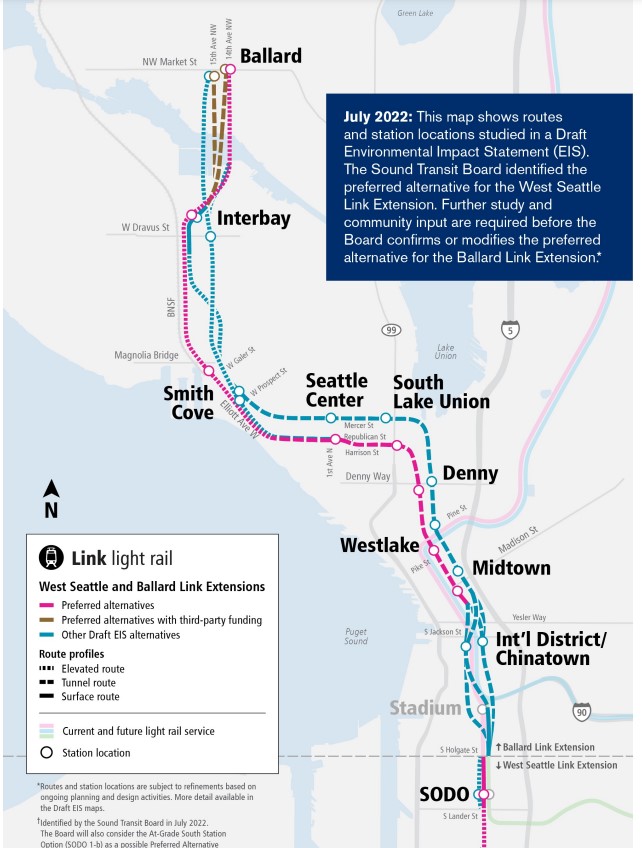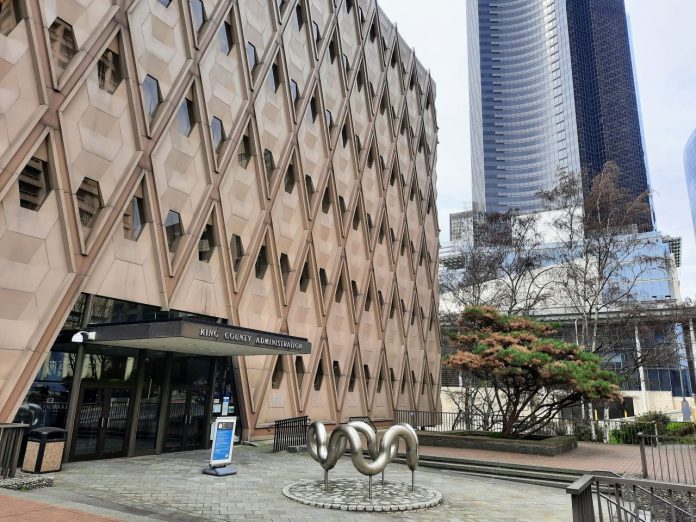
King County Executive Dow Constantine has teased a vision for overhauling the County’s campus in Seattle’s South Downtown, which he pushed as a selling point for his proposal to site a light rail station onto the campus after abandoning previous station plans for Midtown and Chinatown. While more than a year has elapsed since Constantine floated the plan, few firm details have emerged. The plan remains a loose sketch, with plenty of ideas floating around but no driving vision for what the County is actually after and how it plans to achieve it.
Nevertheless, the campus redevelopment is being used to steer generational, billion-dollar light rail decisions. Supporters of moving the station onto the campus argue it as a point in their favor, and some have criticized the original station locations in Midtown and next door to the existing Chinatown-International District (CID) station as offering fewer transit-oriented development opportunities. Supporters of the CID station have pointed to the superior transit hub and transfer environment the site would offer.
At Sound Transit’s open houses dedicated to the topic of CID light rail, posterboards and other materials have shown a large development sprouting from the agency’s new Pioneer Square station, taking the place of today’s County Administration Building, which is presently shuttered as office needs have shrank in the pandemic era. While not pictured as a highrise rivaling Columbia Center or the 100-story megaproject that Constantine floated last spring as he announced support for switching station locations, it does appear to be a substantial redevelopment of perhaps 20 stories in Sound Transit’s visioning, which granted are for illustrative purposes only.
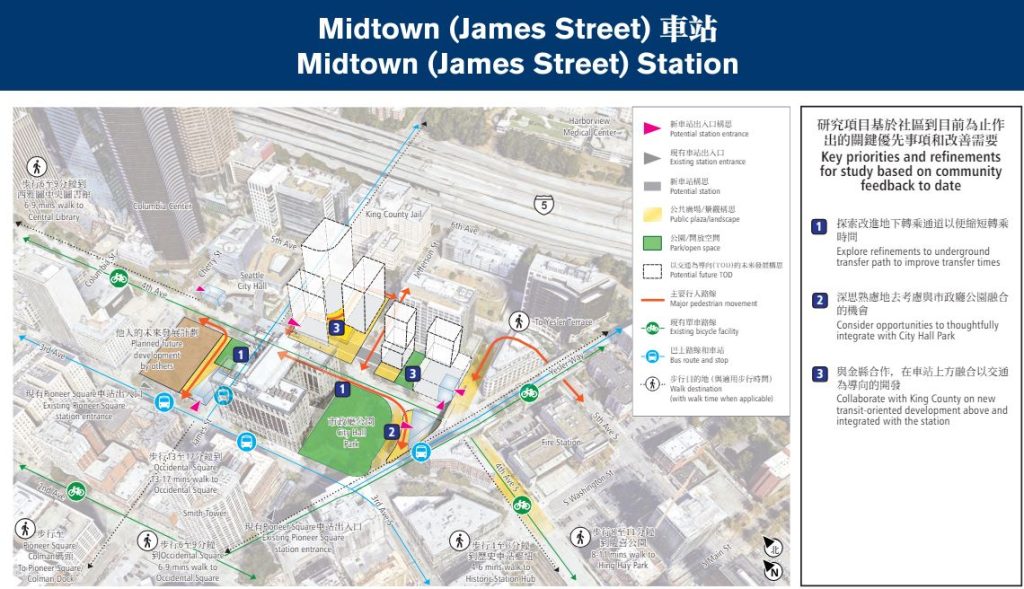
In addition to running King County government, Constantine also chairs the Sound Transit board, making him the most powerful official at that agency as well. If anyone is in a position to tackle a collaboration of this magnitude, it would be him. However, since pairing of projects is 15 years away from completion at best, it means Constantine will be passing the concept off to successors at both agencies. Even the year and a half remaining in his term may not be enough to get plans of this magnitude off the ground, especially at the pace achieved thus far.
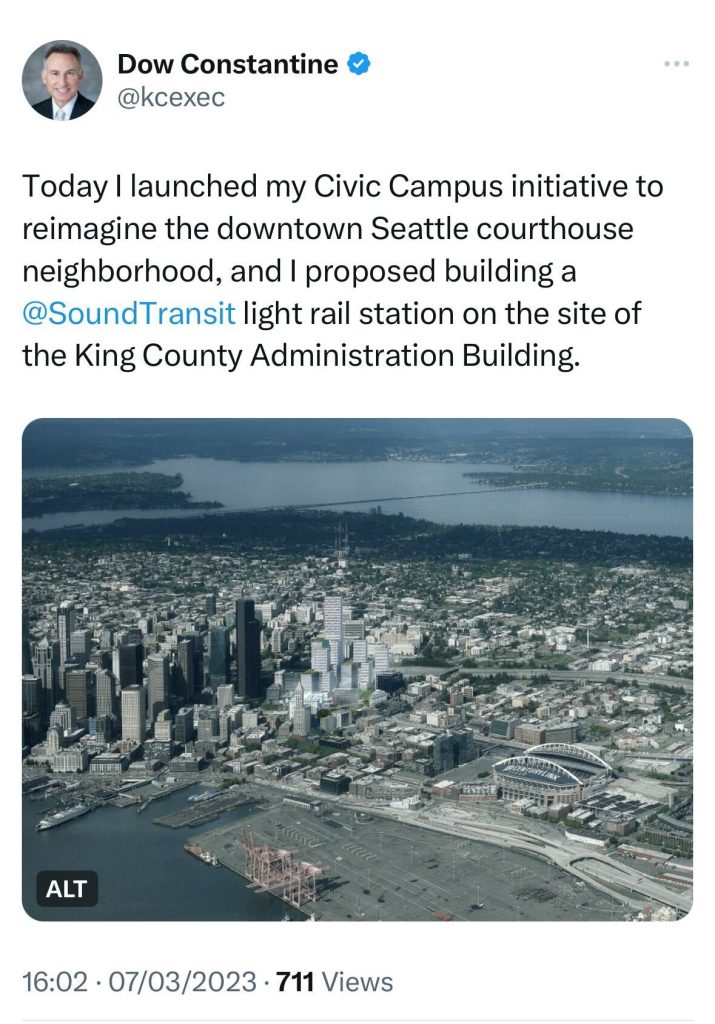
The 10 stations of Ballard Link are slated to open in 2039, after four years worth of planning delays setting back the Sound Transit 3 (ST3) project approved by voters in 2016. Constantine is not expected to seek a fifth term as County Executive, which would also mean he will lose his perch on the Sound Transit Board.
A spokesperson for the County Executive did not respond to a request for comment for this story. However, Constantine delivered his 15th state of the county speech Tuesday, and he did bring up his Civic Campus Initiative.
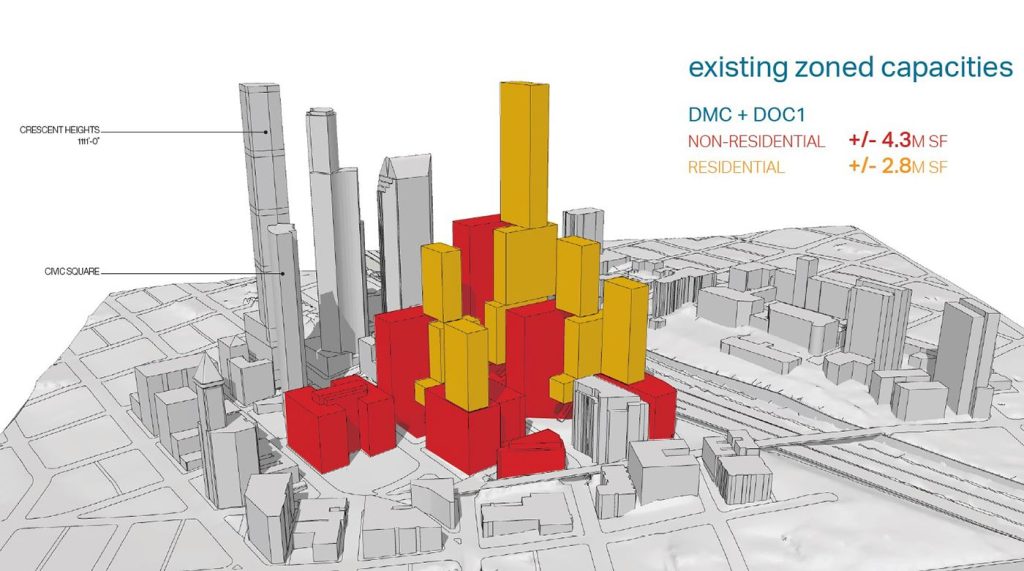
“The [Doors Open cultural grant] implementation plan you will consider in the coming months will move us closer to our ideal of being a place where every person is seen and heard and can thrive, people of different backgrounds, different ages, different incomes, living, working, learning, together,” Constantine said. “That is what civic vitality looks like, and it’s also the vision at the heart of my proposal to create a new neighborhood right here, where you are meeting today, and on the many underused blocks around this century-old courthouse.”
The executive referenced a graduate student design competition hosted by the Urban Land Institute that used the King County Campus overhaul as a test case for student teams from around the country. A proposal called “Meander” from a Georgia Tech team won the competition. Although their proposal included no skyscrapers, a series of midrise buildings managed to add about 2,100 homes at a range of incomes.
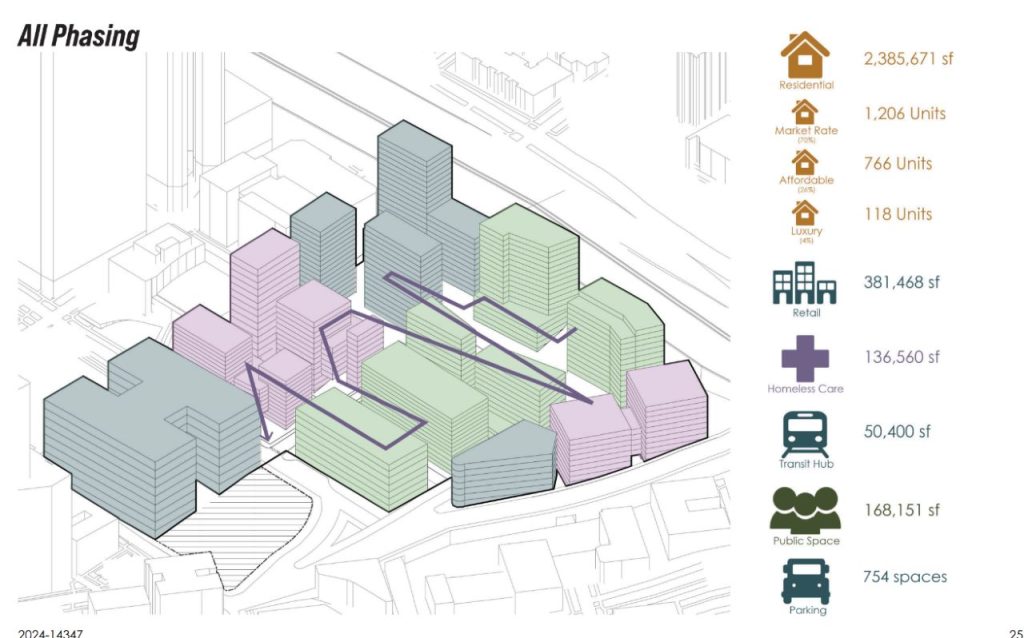
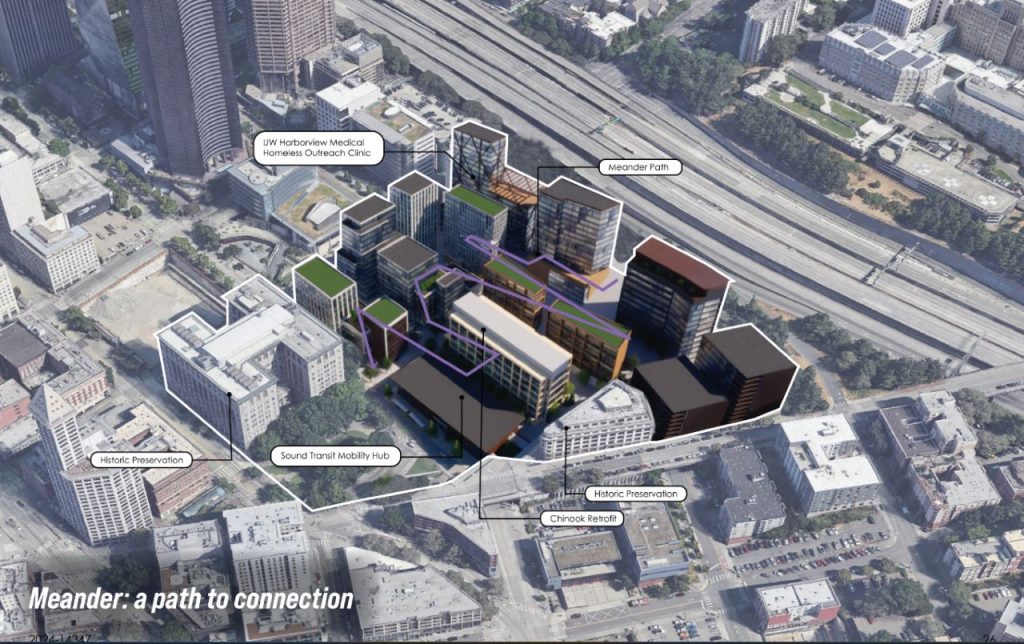
“Since I last spoke with you about the future of our civic campus, we have gathered ideas from community and government partners,” Constantine said. “The Urban Land Institute selected our project for its annual design competition, with student teams from around the nation visiting with fresh eyes and new perspectives. And the University of Washington College of Built Environments is creating an entire five-credit course around the Civic Campus Initiative.”
Constantine’s annual speech did sketch a vision that included thousands of homes in a green eco-district.
“Why are people excited about this? Because we have the opportunity to do something truly extraordinary here,” Constantine said. “We can create thousands of units of housing for people of all incomes, with affordable retail spaces and safe public places for those thousands of residents to meet and mingle and be in community. We can restore historic buildings like this one, create a low-emission, clean-energy district, and leverage the value of the county’s considerable land holdings to help make it all possible.”
It is an inspiring vision, if it can be pulled off, but the County’s track record on complex transit-oriented development projects has been less than stellar. The County also owns a large park-and-ride site next to Northgate Station, but redeveloping that saga turned into a bit of a nightmare. An early study floated 24-story towers as an option, but the County ended up calling a second Request For Proposals process after not liking the first batch of submissions. Ultimately, the County opted to redevelop a small corner of the site, and leave the rest of the site as a parking lot, arguing the parking capacity would be needed until the Lynnwood Link extension opens.
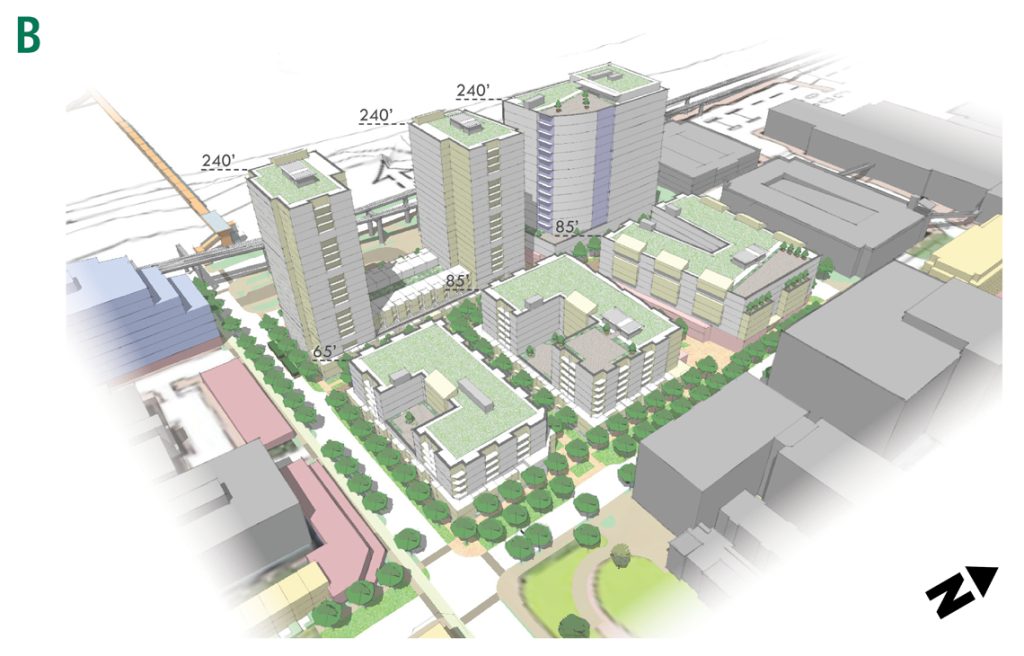
Former District 5 Councilmember Debora Juarez summed up the situation in 2018: “I’m disappointed that Northgate may become the textbook example of how not to do transit-oriented development. I thought we were going to be the shining example of how to do it.”
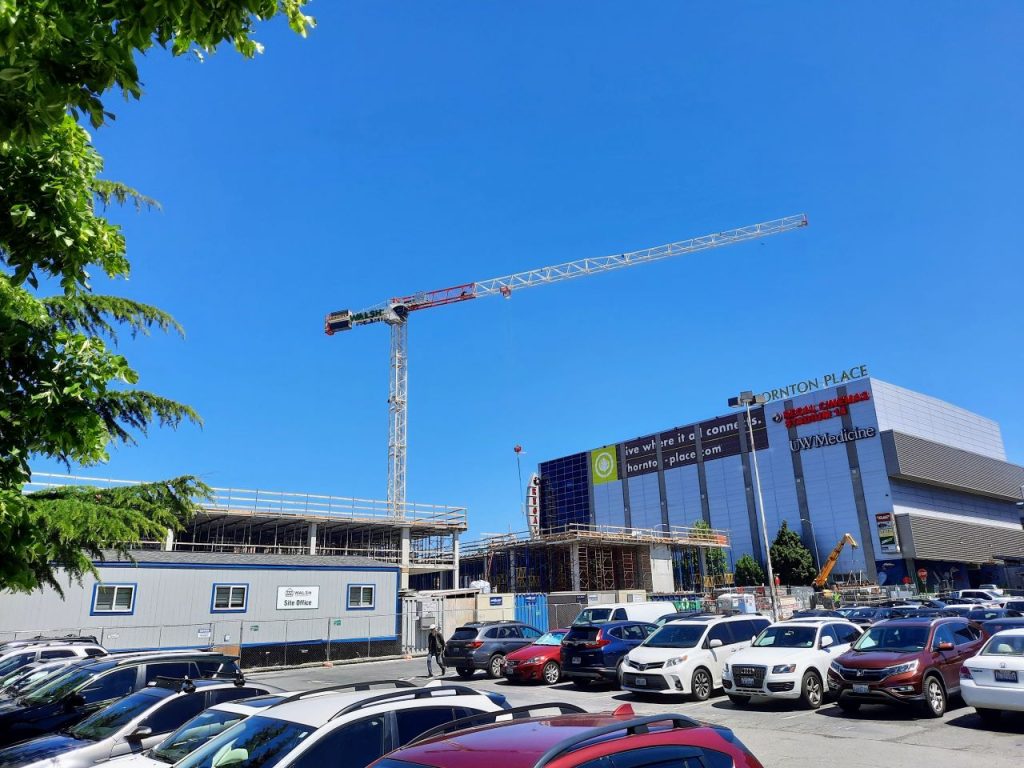
The County site remains absent of any housing three years after light rail opened, although 235-home affordable complex by Bridge Housing is under construction. And despite the Lynnwood Link’s August 30 opening fast approaching, redevelopment plans for the remainder of the Northgate park-and-ride have not appeared to go anywhere yet.
Is the County queuing up a similar mess if it thinks it can coordinate a delicate multi-billion-dollar light rail project with a multi-billion-dollar mixed-use redevelopment while meeting a wide variety of goals — environmental, housing affordability, historic preservation — and using an unspecified land value capture scheme to fund it?
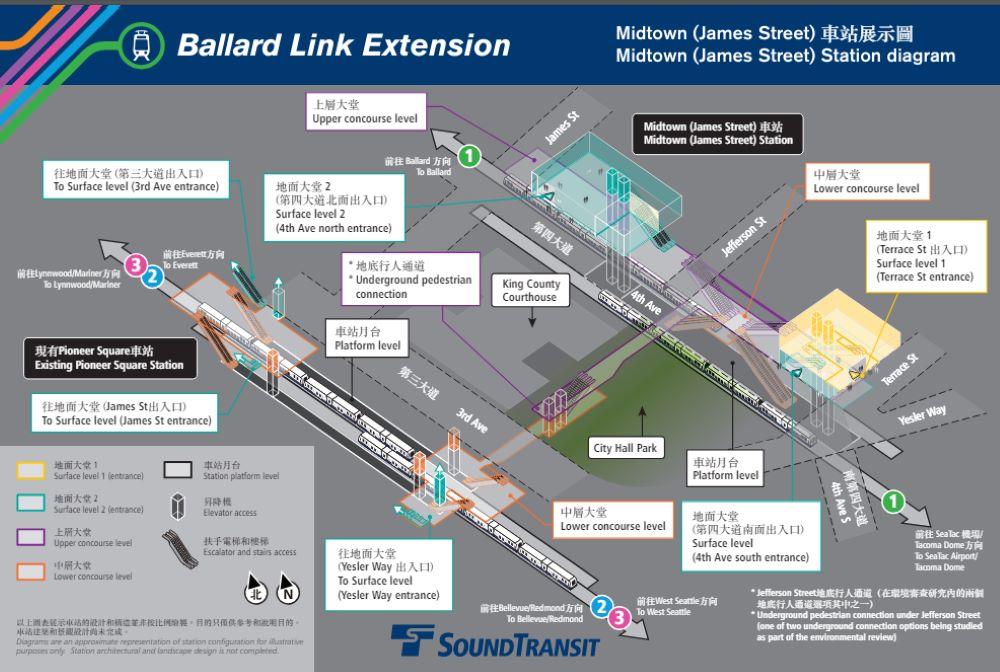
South Downtown already has a growing list of stalled development projects, from Urban Visions developer Greg Smith’s S Campus office complex just south of the CID (where Sound Transit is planning to site a station after abandoning Midtown and CID station plans) to the gaping pit outside of Seattle City Hall. The pit serves as a constant reminder for policymakers of how tenuous ambitious redevelopment plans can be, as they look out their office windows into the chasm.
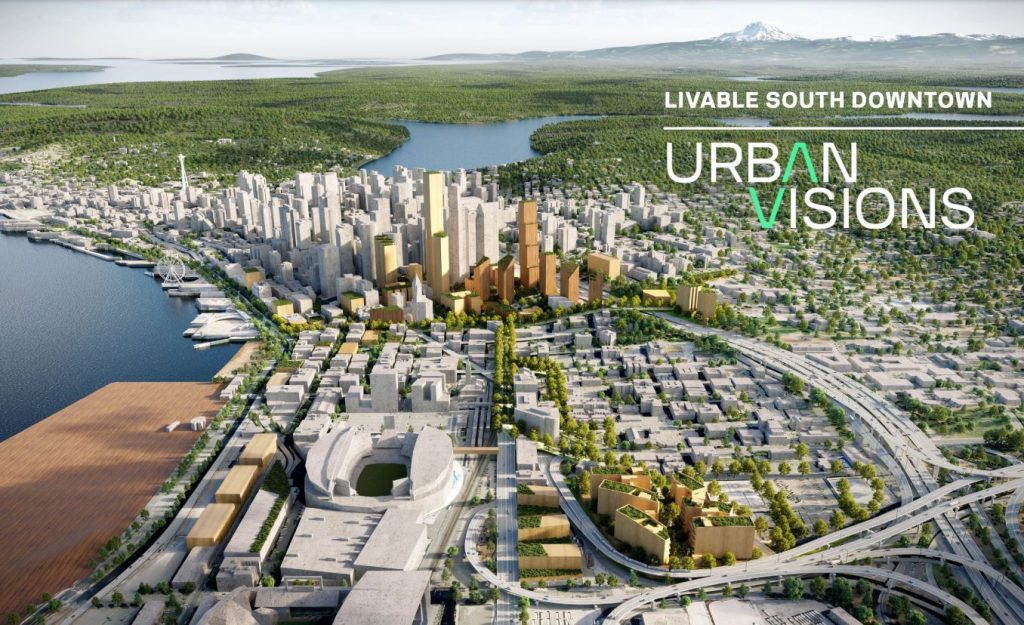
An earlier tower proposal for the “Civic Square” site fell through after the developer allegedly sought to blackmail a Seattle City Council candidate. A more recent 58-story proposal is shovel-ready but yet to break ground, perhaps waiting for financing, an opportunity to charge higher rents, or a certain alignment of the stars.
Similarly, a 100-story proposal from Miami developer Crescent Heights has also long been in limbo, and the developer recently listed the property for sale, suggesting their hope of completing the project is rapidly dimming. Crescent Heights purchased the 4th Avenue and Columbia Street site for nearly $49 million in 2015, but they are listing it at $40 million, a steep discount with a decade worth of inflation worked in.
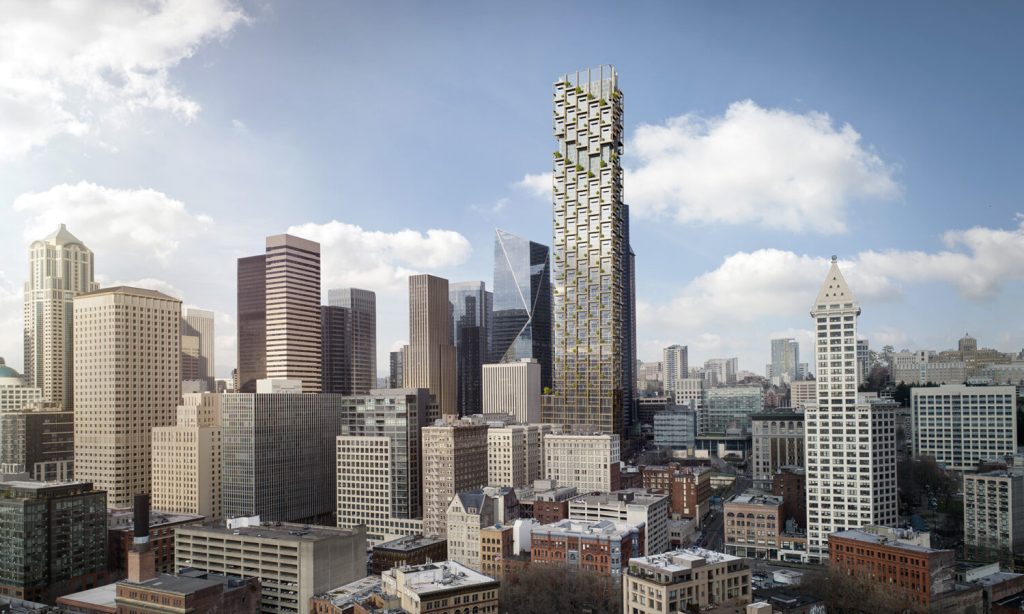
In 2023, Smith’s Urban Visions firm has put out a report laying out their vision for the county campus. It includes lots of tree covered towers and a full pedestrianization of Third Avenue, removing the region’s busiest bus mall, which has long been an idea that the Downtown Seattle Association has toyed with to varying degrees.
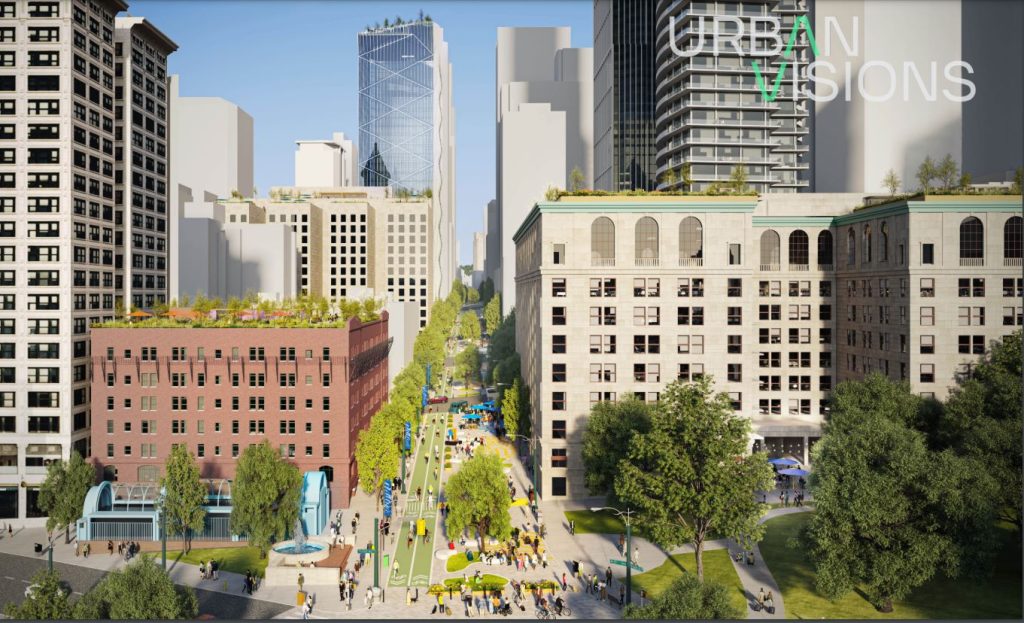
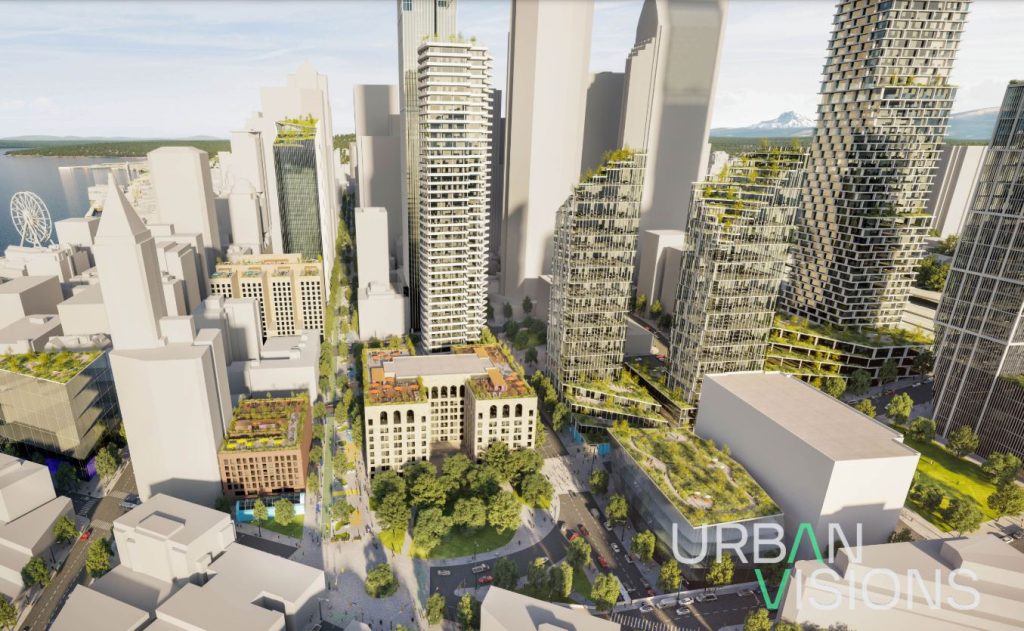
What is also not clear in Constantine’s vision is whether the County’s civic campus overhaul would include office space for itself. Is the Civic Campus Initiative hinging on establishing a new headquarters for county government elsewhere? That question lingers, but the decision to relocate or disperse government offices throughout the county could prove a stumbling block in its own right. For now, the County is actually increasing its footprint in Downtown. Earlier this year, the county quietly purchased the nearby Dexter Horton building, where the county rents some office space, at a bargain-basement price for Downtown Seattle anyway — $36.6 million.
Like Constantine, Seattle Mayor Bruce Harrell and his team appear excited about the idea of redeveloping South Downtown and creating a new neighborhood around the County campus and surrounding blocks. Harrell also mentioned the idea in his annual State of the City speech in February, pledging a “very coordinated targeted growth strategy” for South Downtown.
“With several major projects on the way, it’s a rare alignment and gives us a unique opportunity we haven’t seen in decades to design and foster a new neighborhood that demonstrates the downtown is for everyone,” Harrell said. “So when I talk about big ball in our administration, this is it a chance to significantly increase people living downtown with affordable housing and grocery stores and childcare and high quality jobs.”
A publicly-owned five-acre parcel across from Lumen Field, called the WOSCA site, is set to be redeveloped, getting the ball rolling on that strategy. However, the only thing determined so far is that the site would get a temporary use until after the 2026 World Cup, for which Seattle will be one of the host cities. Still, Markham McIntyre, director of the Seattle Office of Economic Development, said early talks to coordinate projects have gone well.
“The City of Seattle continues to see tremendous potential for alignment and collaboration among public agencies around multiple redevelopment efforts on the horizon in South Downtown,” McIntyre said in a written statement. “Our initial conversations with our counterparts have been very encouraging; we’re seeing mutual interest in working together on opportunities such as ST3 and the associated transit-oriented development, and the future of the five-acre WOSCA site. This level of coordination and alignment will help us realize our shared interest of revitalizing Downtown.”
The idea of a revitalized South Downtown is launching a thousand visioning exercises right now. Clearly this idea has some cachet, with people wanting the area to be more than a forlorn collection of aging office buildings and parking structures that are largely empty and deserted after office hours. It will be interesting to see if any of these expansive visions eventually land into the province of reality.
Update: This article was updated at 12:42pm with the Urban Visions renderings and the Crescent Heights tower.
Doug Trumm is publisher of The Urbanist. An Urbanist writer since 2015, he dreams of pedestrian streets, bus lanes, and a mass-timber building spree to end our housing crisis. He graduated from the Evans School of Public Policy and Governance at the University of Washington in 2019. He lives in Seattle's Fremont neighborhood and loves to explore the city by foot and by bike.


